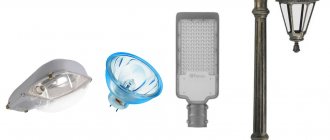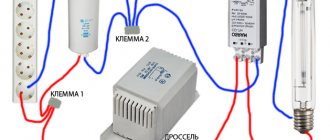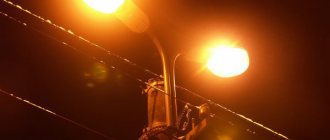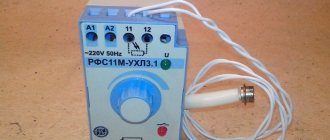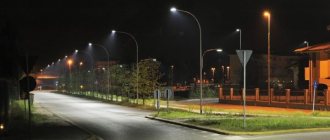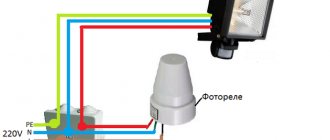05/08/2020 366 Lighting
Author:Ivan
HPS lamp is a high-pressure sodium arc tubular lighting source. The main feature of the light bulb is the large deviation of the emission spectrum towards the red region, as well as an increased pulsation coefficient. This leads to disruption of the color rendering of objects. Therefore, HPS light sources are not used to illuminate residential buildings, as well as industrial premises.
[Hide]
Specifications
The main ones include luminous flux, luminous efficiency and operating time.
There is a direct relationship between the power of the element and the resource - high-power models last longer. Below are the technical characteristics of popular HPS sources with a power of 150, 250 and 400 W. All of them are connected to the lamp using an E40 type socket at a voltage of 120 V.
DNAT 150
Technical characteristics of the lamp DNaT 150
| Power, W | Flow, Lm | Light output, lm/W | Length, mm | Diameter, mm | Resource, h |
| 150 | 14 500 | 100 | 211 | 48 | 6 000 |
DNAT 250
Technical characteristics of the lamp DNaT 250
| Power, W | Flow, Lm | Light output, lm/W | Length, mm | Diameter, mm | Resource, h |
| 250 | 25 000 | 100 | 250 | 48 | 10 000 |
DNAT 400
Technical characteristics of the lamp DNaT 400
| Power, W | Flow, Lm | Light output, lm/W | Length, mm | Diameter, mm | Resource, h |
| 400 | 47 000 | 125 | 278 | 48 | 15 000 |
Principle of operation
As mentioned earlier, HPS requires special equipment to run. You can't just turn on the light bulb. To create an electrical charge in the burner, a high voltage source is needed. This is why a pulsed ignition device (IZD) is used.
During startup, the burner is cold and its electrical resistance is minimal, so the current rapidly increases in the circuit, which can cause the electrodes to overheat and break. To prevent this from happening, the kit for connecting the DNAT 250 is supplemented with a choke. During operation of the device, a magnetic flux is created, which is directed opposite to the current that generated it.
When the ignition device is connected, it begins to generate high voltage pulses into the burner. Then an arc forms in the gas-discharge medium and the lamp lights up. And the inductor is responsible for the normal functioning of the device and voltage stabilization.
Not so long ago, modern lamps appeared that do not require the mandatory use of IZU. A ballast is already built into their body.
Recommendations for selection
For specific use, lamps are selected according to the type of installation solution (column, floor lamp, string, wall). The problem of obtaining the required illumination (in lux) is solved by the power of the lamp, the type of reflector (reflective or white flat) or diffusing element. The color of the flow can be changed by the color temperature of the lamp or by selecting a filter in the lampshade.
It is also important that the style of the lamp matches the architecture of the house. Thus, a stylish minimalist lamp fits well into the facade of a modern building with a flat roof and rectangular architecture, while lamps reminiscent of antique gas lanterns are more suitable for a classically shaped house.
When choosing a lamp, one should not forget about economics: street lamps should consume the minimum possible amount of energy. Automation should help with this, switching the maximum flow rate to average, minimum and zero according to the selected program, photo relay or timer.
Design selection
The most popular types of street lighting are those that not only illuminate the area, but also make it more attractive. The most popular types of street lighting have become decorative lamps, floodlights and those equipped with solar panels.
The largest selection includes decorative lamps. Their wide variety makes it possible to realize almost all the ideas of designers and architects. At the same time, performers must remember that the moisture protection of external lamps must be at least IP44. Otherwise, devices installed in an open space must be under the roof (terrace, veranda, balcony).
Spotlights are equipped with halogen and high-power LED lamps, which differ from each other in service life and energy consumption level. Spotlights are also selected based on their scattering angle - the larger it is, the larger the illumination area. LED spotlights are often equipped with a motion sensor, which lights up the device only when a person appears in the capture zone.
When choosing street lighting, a group of solar-powered lamps is becoming increasingly important. They are produced mainly in the form of low posts pressed into the ground, but the number of options is growing. The latest samples give quite decent light at night after a daytime charge. There are also spotlights that operate in an energy-saving mode with a motion sensor.
Classification of street lamps depending on design
Methodology for calculating lighting in domestic and industrial premises
Street lamps are structurally different, which is caused by the installation features.
Street ground lamps are represented by three types of devices.
- Reflector lights: illuminate highways and major highways. The light flux from a 250-400 W lamp is focused and converted into a directional one.
- Lamps with diffused lighting: used for equipment on secondary highways. The lamp power is selected within the range of 70-250 W.
- Forged street lamps with diffused lighting: the lampshade can be cylindrical or spherical. Lamp power – 40-125 W. Pedestrian areas (paths, sidewalks, squares) are equipped with such lamps. A variety of them can be pendant street lamps. A lantern of complex shape may have a cantilever fastener.
In addition to ground-based ones, there are street lighting lamps of other designs.
- Facade lamps are most often spotlights. They are mounted on walls, installed on parapets and directly on the ground. The latter are used to equip stairs and garden paths.
- Street ceiling lamps are mounted above the porch of entrances, in the halls of open-type stations. Another option is outdoor recessed lights.
- A street lamp suspension can decorate the front porch.
- The built-in waterproof device is used to illuminate fountains.
When choosing an outdoor lighting lamp, it is necessary to take into account not only its main characteristics. The device must be organically combined with the architectural style of the building. And it is desirable that it be inexpensive.
Types of lighting fixtures
In plant growing, high-pressure sodium lamps are used for greenhouses. NLVD are divided into the following types:
- HPS are ordinary arc lamps with powerful light emission. One of them is quite enough to illuminate a small garden structure. The emission spectrum of such devices can be changed by combining them with other types.
- DNaZ – lighting sources with a mirror reflective layer. The layer is applied to the inner surface of the flask. It is effectively protected from adverse weather conditions and mechanical stress and increases productivity. Sintered electrodes are located inside the flask. They provide high efficiency and reduce energy consumption. Compared to HPS, mirror lamps are not powerful enough.
- DRI and DRIZ are the most advanced devices for greenhouses. Metal halide devices are resistant to current surges, they last a long time, they have the most optimal radiation spectrum necessary for seedling growth, and high efficiency. But they are not without some disadvantages, the most important of which is the cost, which is quite high for the average consumer. Plus, they require a special cartridge to use. This makes it difficult to replace failed lamps.
The device of sodium lamps
Externally, these lamps are similar to DRL. The outer body is a cylindrical cylinder made of glass, but it can also be in the shape of an ellipse. It contains a “burner” - a tube inside which an arc discharge occurs. The electrodes are located at its ends. They are connected to the base. Sodium is not used in the manufacture of the “burner”, since its vapors have a rather strong effect on the glass body. In addition, the outer flask also plays the role of a “thermos” - it isolates the burner from the external environment.
The figure mentions a getter. It is rarely mentioned in reference documentation. A getter is a gas absorber, an adsorber. It is capable of capturing and retaining gas with the exception of inert ones. It finds its application not only in gas-discharge lamps, but also in radio electronics - electric vacuum devices. Its main function is to increase service life. The absence of foreign substances reduces “poisoning” of the electrodes.
The burner itself is made of polycor - polycrystalline aluminum oxide. It is obtained by sintering. Moreover, only the alpha form of the crystal lattice is acceptable for the manufacture of the discharge tube body. It is characterized by the maximum density of “atomic packing”. This is a development by General Electric. The developer called this material “lucalos”. It is resistant to sodium vapor and transmits about 90 percent of visible radiation. For example, dnat 400 has a tube 8 centimeters long and 7.5 millimeters in diameter. With increasing power, the size of the “burner” increases. The electrodes are made of molybdenum. In addition to sodium in vapor form, an inert gas, argon, was pumped in. It is required to facilitate discharge formation. To improve light output, mercury and xenon are introduced. When the lamp is operating, the temperature in the burner reaches 1200-1300 Kelvin. About 13,000 Celsius. To prevent damage, air is pumped out of the flask. The vacuum is quite difficult to maintain, since thermal expansion can cause microscopic cracks and holes to appear. Air can enter through them. To eliminate this, special gaskets are used. The flask does not heat up as hot as the burner. The usual temperature is 1000 C. The glow shows orange, yellow, and golden colors.
Previously, lamps had only a round threaded base, like household incandescent lamps. However, recently a new type of base has appeared - Double Ended.
Regardless of the design, the spectrum will be approximately the same.
This type of lamp is mainly used by agricultural enterprises. They are usually twice as thin as a standard sodium lamp. The flask is made of quartz. There is nitrogen inside the flask. The burner has two electrodes for supplying a pulse and subsequent supply voltage to maintain the discharge. The leads are located at the ends of the lamp; this is a more advanced solution that avoids thermal deformation of the bulb.
HPS lamps with two burners have also been developed.
The variety shown in the photo is usually used for greenhouse placement (for supplementary lighting purposes). The second burner is a metal halide lamp. In fact, this model is a hybrid of DNAT and MGL in a single package.
But there are also models that contain a pair of identical burners. They are located in a common cylinder and connected in parallel. This is done to alternately use each of the gas-discharge tubes. During operation, only one emits light. The one that lights up is the one where the conditions are more suitable. This solution reduces overall operating costs. Otherwise, the options with one or two tubes do not have any fundamental differences; the power and luminous flux parameters will be the same. The schematic diagrams do not change.
Device
Structurally, a HPS sodium lamp is very similar to other gas-discharge devices. It looks like a glass flask in the shape of a cylinder with a base.
Structure of DNAT:
- The outer casing is made of heat-resistant durable glass.
- A discharge tube in which an arc is formed.
- Electrodes.
- Ceramic plug.
- A niobium rod that communicates with the internal cavity of the burner.
- Barium rod that absorbs gas.
- Screw base.
Inside the flask there is a burner, along the edges of which there are electrode elements. The aluminum oxide from which the discharge tube is made makes it resistant to sodium vapor. It transmits about 90% of light.
There are gaskets inside the case that prevent air from entering it. The temperature in the burner can reach about 1300°, if oxygen gets into it, the light bulb can crack or explode. This is precisely what the gaskets protect from, maintaining a vacuum inside the flask.
Scope of application of GL
Characterized by a wide range of applications:
- street lighting in urban and rural areas, in lanterns for illuminating parks, squares and pedestrian paths;
- lighting of public premises, shops, production facilities, offices, trading floors;
- as illumination for billboards and outdoor advertising;
- highly artistic lighting of stages and cinemas using special equipment;
- for vehicle lighting (neon);
- in the lighting of the house.
Spotlight: scope and types
For open spaces, for lighting:
- industrial areas;
- sports complexes and stadiums;
- quarries;
- facades of buildings and various structures;
- monuments;
- memorials;
- entertainment shows;
- livestock complexes.
There are:
- asymmetrical;
- symmetrical.
| View | Application area |
| For strobe | Pulsed gas-discharge lamps of the IFK-120 type are used in photo flashes. The stroboscopic effect is often used in nightclubs: dancers in a darkened room are illuminated by flashes, while they look frozen, and with each new flash their poses change |
| For street lighting | The GL light source for street lighting is the combustion of gaseous fuel, which contributes to the formation of an electrical discharge: methane, hydrogen, natural gas, propane, ethylene or other types of gas. A factor for using GLs for street lighting is their high efficiency (luminous efficiency - 85-150 lm/W). Often used for decorative street lighting, the service life reaches 3000-20000 hours |
| For plants | As a rule, general-purpose LLs, high-pressure mercury lamps, sodium GLs, and advanced metal halide lamps are used to illuminate a large winter garden. You can use one or more ceiling lights with fairly powerful (from 250 W) gas-discharge metal halide or sodium diodes |
Disadvantages and advantages of GRL
| Disadvantages of gas discharge lamps |
|
| Advantages |
|
| Advantages |
|
Installation of induction lamps
Despite many differences in the immediate operating process, induction devices still belong to the segment of common gas-discharge lamps. The main feature of such lamps is the absence of electrodes. However, this difference is also conditional. The basis of the design is also a flask that contains plasma - it acts as a generator of light energy. In addition, induction lamps are complemented by a gas cylinder, which is located next to the magnetic coil. Such devices are called electrodeless for the reason that direct contact of the working element with the gaseous environment is not provided. Also, the absence of classic metal electrodes inside the cylinder increases the service life of the device. As practice shows, lamps of this type are not recycled until the phosphor resource is used up. This corresponds to approximately 100,000 operating hours of the device.
Connection features
There are many options for connecting HPS. A typical connection looks like this:
The peculiarity of this process is associated with the need to use a choke - a ballast, since all gas-discharge types of lamps are characterized by variable resistance. Without the limiting functions of the throttle, the gas inside the lamp overheats very quickly, which can result in failure of the device or even its explosion.
As for the ignition device, a number of enterprises produce HPS that function without it. An alternative to the IZU is a launch antenna, pre-wound around the tube.
How to make a sodium lamp lamp
Since it is advisable to use HPS products in the household, the use of such light bulbs is relevant for many. But for their operation you will need special lamps. Their cost is high, so it makes sense to build a lighting device with your own hands.
What will you need?
To complete the task you will need:
- a metal-coated plate, its dimensions should be 35x40 cm;
- aluminum sheet that will be used as a reflective element;
- set of self-tapping screws;
- hammer;
- metal scissors;
- pipe with a diameter of 15 cm.
User Anatoly King Crimson spoke in detail about the preparation for the manufacture of a lamp for a HPS light bulb, as well as the creation of such a device.
https://youtube.com/watch?v=mbmFqzkRe_I
Step-by-step instruction
DIY Assembly Guide:
A metal-coated plate is prepared. It should have a mirror surface on the working side, and also be elastic and rigid. If it is not available, it is possible to install a stainless steel plate; this material is used in chimneys. The reflective element is designed to focus the light energy of the device and direct the lighting flux to the desired location. To calculate the dimensions of a reflex device, you can use special computer software that allows you to accurately calculate the efficiency. The plate is bent manually. When carrying out this task, when the central part is bent, you can use a hammer. The rest of the sheet is bent using a previously prepared pipe. To level the surface, you must act carefully. But this can only be done with your hands. At the next stage, the cartridge with the sodium light source is fixed; it can be secured to the back wall. In this example, it is made from the side cover of the PC processor unit. It is recommended to make holes in advance for ventilation of the system. To make a lid, it must be cut out of metal; special scissors are used for this. The socket is fixed to the back surface of the lighting fixture using homemade pins, the diameter of which is 4 mm. These elements are made from hooks purchased in the store. It is desirable that their threaded part be elongated. This will allow you to make several studs. The reflective device is fixed on the rear wall using special aluminum rivets. Their diameter should be 3.2 mm. If you do everything correctly and securely fasten the elements, the structure will ultimately turn out rigid. Then the throttle element, as well as a high-voltage pulse device, is installed in the lighting device
It is important that these components are suitable in size for the lamp body. For more convenient placement, it is possible to remove the board from the case
But the power plug, as well as the switching device with the filter capacitor element, can be left. The throttle is being installed. This example uses a Galad 250W ballast choke element and is optimally suited to the hull width, height and length. A pulse charger is installed next to it. It should have a wiring diagram for the inductor and light bulb, and you need to follow it. At the next stage, wires must be brought out from the housing to the lighting device; their length should be 3 meters. To connect to the socket, only heat-resistant cables must be used. Their insulation should be made of fiberglass. Then the assembled lighting device is configured; this must be done before using it. The lamp is activated; this must be done in a dark room. You must wait until the sodium light source is completely heated. It is necessary to visually assess the quality of the lighting flux, which is reflected by the reflector device. If necessary, this element is bent, but this should be done before it gets hot.
The reflector adjustment procedure must be performed carefully so as not to catch the light source itself. Otherwise, not only the light bulb may be damaged, but it may also explode. To optimize the luminous flux, you can slightly bend the edges of the so-called parabola on the lamp.
User Dmitriy Rostkov spoke in detail about the creation of a reflective device for a HPS light bulb.
How to connect the lamp?
The connection procedure is performed as follows:
- First, using a multimeter, you need to diagnose the insulation of the inductor and capacitor device. The tester must first be set to maximum resistance mode. You need to make sure there is no breakdown in the body.
- To supply 220 volts to the device and turn it off, a two-pole automatic input device is used.
- If you use one 400-watt lamp, then a 5-6 ampere circuit breaker is suitable for connection. In addition to switching operations, it will also be used as a protective device. Installation of the machine is carried out at the beginning of the circuit. When performing the task, the panel body must be grounded.
- There are two neutral cables coming out of the machine. According to the diagram, one of them goes directly to the light source. The second is connected to the corresponding clamp; on the starting unit it is marked with the symbol N.
- It must be taken into account that the throttle assembly is mounted only in a phase circuit break that goes to the lighting source. It cannot be installed on the neutral cable. Otherwise, you can burn the inductor if a short circuit occurs.
- Then the phase must be switched off. One cable from the automatic device is installed on the inductor terminal. And the conductor coming from the output contact is connected to terminal B on the ballast. The middle electrical circuit must be connected to the socket of the lighting device.
Connection diagram of a HPS device with a three-pin IZU
Connection card for a light bulb with a two-pin pulse charger
Connection diagram for neon lamps.
Gas-discharge light sources are connected to the power source through a resistor. It is inserted into the circuit to limit the current to 1 mA (or better, to tenths of a milliampere). Low current increases service life. Operating a gas discharge lamp without a resistor poses a threat to human health. The use of a resistor prevents the transition of the discharge to an arc, which can lead to a short circuit and explosion of the lamp tube. The design of some light sources immediately includes a resistor: it is mounted in the base. It is worth carefully studying this issue when purchasing.
Discharge lamps require high voltage. A household outlet does not do this. A step-up transformer is required. Its parameters depend on the dimensions of the lamps, their quantity, and the filling gas. The required voltage varies from 2000 V to 12000 V. For example, for lamps filled with neon there is the following dependence of voltage on length.
| Transmitter voltage, kV | Tube diameter, mm | ||||
| 8 | 10 | 12 | 15 | 20 | |
| 12 | 7000 | 8200 | 10000 | 12500 | 18000 |
| 10 | 6000 | 7000 | 8000 | 11000 | 15000 |
| 0,9 | 5500 | 6300 | 7500 | 9500 | 13500 |
| 0,8 | 4700 | 5400 | 6300 | 7400 | 11000 |
| 0,7 | 4100 | 4800 | 5800 | 7500 | 10500 |
| 0,6 | 3600 | 4000 | 4900 | 5800 | 8800 |
| 0,5 | 2900 | 3300 | 4000 | 5000 | 7300 |
| 0,4 | 2200 | 2500 | 3200 | 4000 | 5800 |
| 0,2 | 1000 | 1200 | 1500 | 2000 | 2500 |
| Transmitter voltage, kV | Tube diameter, mm | ||||
| 8 | 10 | 12 | 15 | 20 | |
| 12 | 7000 | 8200 | 10000 | 12500 | 18000 |
| 10 | 6000 | 7000 | 8000 | 11000 | 15000 |
| 0,9 | 5500 | 6300 | 7500 | 9500 | 13500 |
| 0,8 | 4700 | 5400 | 6300 | 7400 | 11000 |
| 0,7 | 4100 | 4800 | 5800 | 7500 | 10500 |
| 0,6 | 3600 | 4000 | 4900 | 5800 | 8800 |
| 0,5 | 2900 | 3300 | 4000 | 5000 | 7300 |
| 0,4 | 2200 | 2500 | 3200 | 4000 | 5800 |
| 0,2 | 1000 | 1200 | 1500 | 2000 | 2500 |
To supply such a high voltage, high-voltage wires are needed. Their insulation must withstand at least 1.5 hours of operating voltage. As an example, let's take the PMVK wire. It is inexpensive, can withstand up to 20 kV, and operates from -60 to +80 degrees.
There are two schemes for connecting lamps to a transformer. The first of them is standard. The lamps are connected in series to the transformer, and the transformer to a 220 V network.
Standard electrical diagram.
Zero point circuit.
The lamps are connected in two groups on opposite sides of the transformer. An equal number of light sources of the same type are used (in terms of size, gas filling).
The zero point circuit allows you to reduce the length of the wires. If one lamp breaks down, only one part of the circuit will stop working, and the second will continue to shine.
Due to its design, cold neon consumes less energy than regular neon. It can be powered from a low voltage power supply. To create the necessary electrical parameters (voltage, frequency), an inverter is built into the circuit. Depending on the model, inverters can be powered by twelve-volt power supplies or five-volt batteries. Up to three meters of neon can be connected to the batteries. And to the 12 Volt power supply - up to twenty meters.
Connection diagram to a power source via an inverter.
When installing, follow these simple rules:
- Wires and lamps should not come into contact with metal. If necessary, use polycarbonate holders.
- If two or more transformers are used, the wires from them are separated at a distance of more than 20 cm.
- The place where the wires pass through the metal is placed in a PVC pipe.
- All metal parts and the transformer must be grounded.
Connection
Since igniting the burner requires a high pulse voltage (sometimes up to 1000 V), this complicates the connection diagrams for sodium lamps. It is necessary to use additional equipment. Ballasts for low-pressure hydraulic valves are of two types: Emballasts (electromagnetic) and electronic ballasts (electronic).
IZUs are connected to the lamp circuit in parallel, and the chokes are connected in series, sometimes through a pulse ignition device.
Figure 6 shows the NLVD connection.
Figure 6. NLVD connection diagram
Pay attention to how the choke (ballast) and IZU are connected.
Please note that when connecting yourself, you must comply with the requirement: the length of the wire from the inductor to the lamp base should not exceed 100 cm.
Some foreign manufacturers supply the market with sodium lighting devices with built-in starting devices in the lamp bulb.
Scope of application
Since the color rendering of HPS is quite low, they are not used for lighting residential premises and workplaces. Most often, sodium light sources are used on the streets; they emit bright, contrasting light, increasing visibility on the roads even in fog and snow.
Areas of application of HPS lamps:
- Lighting systems for large areas, wide streets, highways, highways.
- Background lighting in tunnels, sports complexes, airports, railway stations.
- Illumination of monuments and other architectural structures.
- Lighting of workshops and warehouses where the level of color rendering is unimportant.
- Artificial lighting in plant nurseries, greenhouses, flower beds.
Lighting systems using sodium light sources demonstrate high-quality performance, weather resistance and high energy efficiency.
When choosing a lighting element, you need to clearly understand what function it will perform. After all, you need to choose a device with suitable power.
For greenhouses and conservatories, lamps from 70 to 400 W can be used. Ideally, a sodium lamp for plants should have a power of 150 - 250 W. Artificial lighting increases the growth rate and yield of vegetables, berries, flowers, etc.
With certain restrictions, 400W bulbs can be used for plants. In this case, the lighting equipment should be placed at a distance of 50 cm from the object. It is prohibited to use devices with higher power, as they will simply burn the plant.
Street lamps are usually equipped with HPS at 70 - 150 W. At the same time, for lighting devices it is necessary to select elements with the same power. For example, for 150W lamps a light bulb with the same value is suitable.
It is not recommended to install sodium lamps in home lamps, even with low power. They have a bad effect on the human visual system.
Advantages and disadvantages
Pros of HPS light bulbs:
- High energy efficiency of the lighting device, which makes them competitors to diode elements. Depending on the manufacturer, with a power of 250 W, the lamp can produce up to 130 Lumens. Much in this matter is decided by the type of diffuser, reflector, as well as the quality of the household network.
- Low cost of the device, averaging from 300 to 10 thousand rubles. It all depends on the manufacturer of the product, its power and other factors.
- Operating temperature of the light source. Such light bulbs belong to the category of high pressure devices. During operation, the product, in particular its burner, can heat up to approximately 1300 degrees. This element is installed inside a shell, which is a transparent body made of refractory glass. The flask itself heats up to 300-400 degrees during operation. Thanks to this, the light source can start and operate in a temperature range from -60 to +45 degrees without damage.
- Time-tested technologies. HPS bulbs are almost a hundred years old. During this time, manufacturers were able to get rid of the reasons that could lead to product malfunctions. The spectrum of the light flux was corrected, pulsations by electronic ballasts were removed, and the burners were improved. Almost every country in the world has its own manufacturer of lamps for such light bulbs.
- Light weight of products, although this parameter is almost never indicated by manufacturers. This characteristic can range from 150 to 500 grams.
The user Mr. spoke about various lighting sources, including HPS, as well as their disadvantages. GrowChannel.
Disadvantages of devices:
- Low color rendering index of the light bulb; this minus usually outweighs all the advantages of the product. This parameter is influenced by the protective glass, in particular, the material from which it is made. If it is of poor quality, then with prolonged use it begins to become cloudy and yellow. To avoid such a disadvantage, it is recommended to choose lamps that have tempered borosilicate glass. But this material significantly increases the weight of the lamp, and also increases the requirements for body rigidity, which leads to an increase in price.
- The HPS lamp has large pulsations. This lighting flux parameter can range from 15 to 40%. If you use electronic ballasts, it can be 0%. But due to the high cost, such devices are practically not used. This is due to the fact that in street lamps it is much more important that the lamp is repairable and has a long service life.
- Long start and hot ignition of the light bulb are considered one of the main disadvantages. Depending on the ignition unit, device manufacturer, and environmental conditions, it will take up to 10 minutes to reach operating mode. When sodium lamps are activated on the street, the light sources initially illuminate poorly. Their brightness increases after a certain time. If you abruptly deactivate the light bulb and then turn it on, the device may not activate, this is due to the need for the burner to cool.
There are several types of gas discharge lamps:
Mercury: their light appears as a result of electrical discharges in mercury vapor with which the flask is filled. It is characterized by strong heating of the flask and surfaces that are nearby, which requires the use of heat-resistant materials. Mercury lamps (HLVs) are used in rooms with large square footage. Sodium (DNAT): work like mercury, but the flask is filled with sodium vapor. Protected from environmental influences by special glass. This safety measure is necessary, since sodium lamps are unstable to temperature changes and humidity. Metal halides (MHA): halides are added to the mercury vapor in the flask. They have high power (up to 2 kW), which is considered a guarantee of good room illumination
This is important for equipping large areas and sports facilities. Xenon: consist of tungsten electrodes, between which an electric discharge passes. The flask contains an inert gas and metal salts (mercury or sodium). Fluorescent: energy efficient lamps with a long service life
The big disadvantage is the use of mercury vapor that fills the flask. If the flask is damaged, the poisonous gas will become dangerous to human health. If luminescent devices are turned on and off very often, their service life is noticeably reduced. This characteristic does not prevent the use of these lamps for illuminating city streets. Induction: street lighting comes from ionized gas, which creates a plasma glow. The lighting is controlled using an inductance coil that generates a magnetic field.
LED floodlights for street lighting should be placed in a separate group. This light source is gradually being replaced by the ones listed above.
The outdoor LED lamp has the following characteristics:
- high efficiency;
- long service life (100 thousand hours or more);
- efficiency: electricity is not wasted on heating nearby objects. Serves to create a luminous flux
- resistant to various climate changes
- durable and not afraid of moisture
Features of operation
HPS 250 gets very hot during operation, so you need to follow some rules when using the lamp:
- Do not touch the housing for 15 minutes after turning off the lamp.
- Do not touch the light bulb with bare hands; grease will remain on the bulb, which will turn into dark spots after heating the device. Then the risk of damage to the hull in these areas increases.
- Provide ventilation to the light source and ballast as they need to be cooled. Install them at a considerable distance from flammable devices.
Protect the lighting element from impacts, as when it explodes, fragments fly over a long distance. If the burner is damaged, mercury will enter the room, then it will need to be disinfected.
HPS lamp design
Structurally, the light source includes the following elements:
- 1 - plug made of ceramic;
- 2 - ceramic tube designed to transmit light flux;
- 3 - outer flask made of refractory glass;
- 4 - electrode element of the light bulb;
- 5 — niobium rod;
- 6 - gas absorption element called barium rod;
- 7 - lamp base.
Schematic structure of a sodium lamp
Description of the labeling of DNAT type lighting sources:
- D - arc;
- Na - sodium;
- T - tubular.
Types of lamps
It should be noted that light bulbs can be separated from each other depending on the design:
- The light source can be manufactured in a transparent cylindrical outer bulb with a threaded base element.
- The device body can be made in the form of an ellipsoid. It will be matte or completely transparent. The light bulb is equipped with a threaded base.
- The flask itself can be cylindrical, made of quartz or glass. The lamp pinout will be double-sided.
- The device body can be manufactured in a special flask. The light bulb is equipped with an internal reflective element.
Metal Halide Lamps
These lamps are similar in design to mercury lamps. In addition to mercury, they contain added metal iodides. These lamps are one of the most efficient light sources. They are superior to mercury lamps in terms of luminous efficiency and light transmission coefficient.
These lamps should not be confused with halogen lamps, which are similar to incandescent lamps and are not gas discharge
Comparative spectra of a mercury lamp (top, left) and lamps with iodide additives are shown below. As you can see, the addition of iodides improves the spectrum of the lamp. Typically, lamps come in two types: with additions of sodium, thallium and indium iodides and with additions of sodium and scandium iodides. Other metals can be added to special lamps, such as rare earths - deisprosium, etc. (bottom right). Such additives make it possible to obtain lamps with high luminous efficiency and other improved characteristics, but such lamps are very expensive and usually have a short service life, about a thousand hours.
The spectrum of a DRI lamp with the addition of indium, sodium and thallium iodides is shown in the figure
The spectrum of a DRI lamp with additions of sodium and scandium iodides is shown in the figure
- DRI lamp with sodium and scandium iodides
- DRI lamp with sodium, indium and thallium iodides
- HPS sodium lamp
| to the top of the page back to the table of contents |
